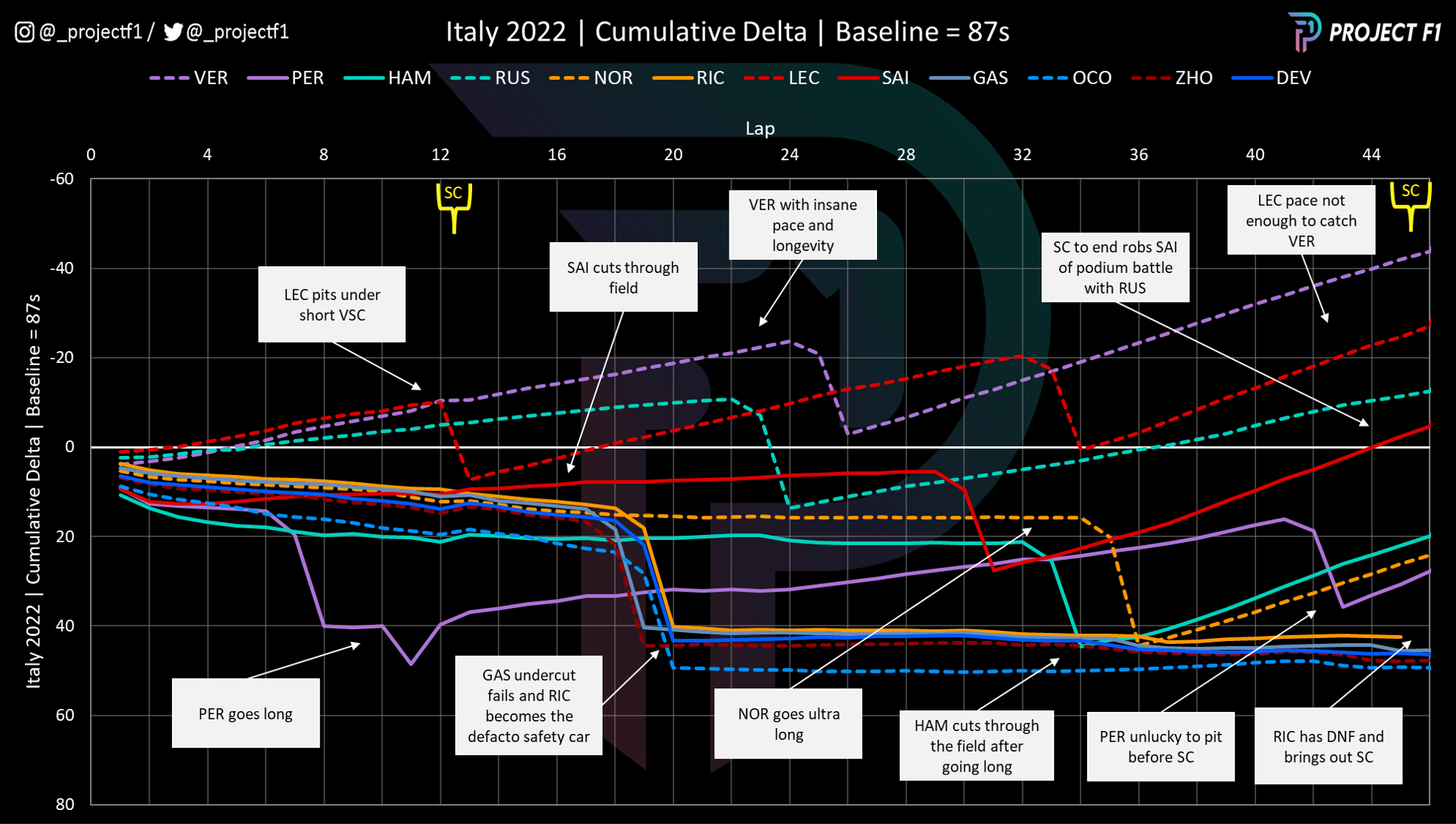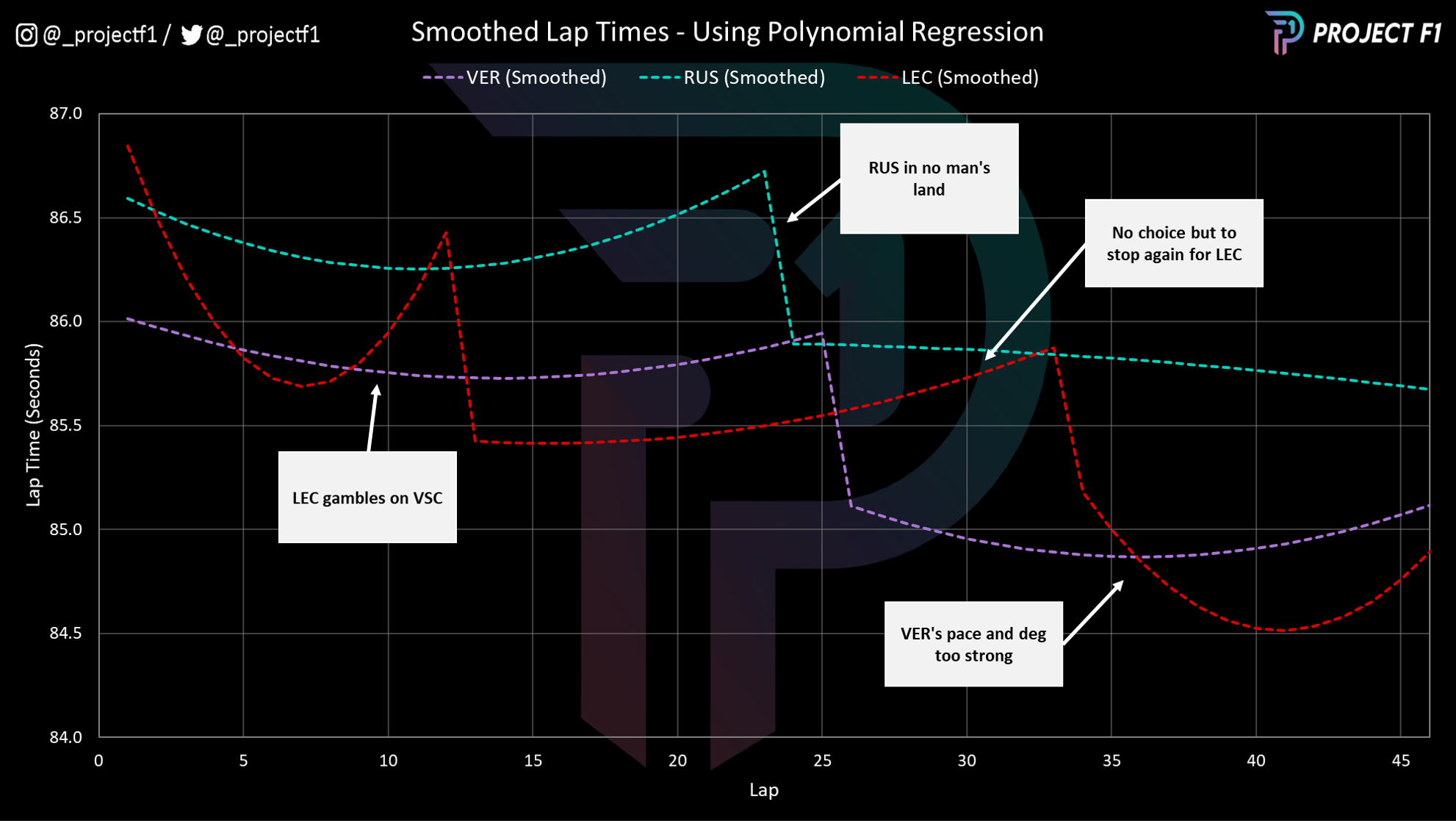Ricciardo Splits Fortunes in the FIeld - Italy 2022
This weekend's Italian Grand Prix attracted high expectations thanks to a resurgent Ferrari and a mixed up grid. Yet despite all of this, the race lost its fizzle thanks to an ill-timed safety car that brought the cars to the chequered flag. It was a finish that left many race narratives unresolved but a closer look at the data can gives clues to infer what could have been. Let's jump straight into it.
Ricciardo’s Influence Went Further Than The Safety Car
Chart 1: Race Story - Cumulative Delta Plot
As usual we start our exploration with a look at a cumulative delta plot as shown in Chart 1 that neatly summaries all the key features of the race. Amongst all the information in this chart, the key detail to hone in on is the race trace for Daniel Ricciardo. The Australian started the race in a solid P4 thanks to a better than average qualifying performance as well as the myriad of grid penalties for multiple drivers. Ricciardo also had a good start unlike his teammate, Lando Norris, who dropped down the field into P6. The 2021 Monza champion was holding his own against those behind but was quickly falling away from the front runners. This trend continued well into the first half of the race and when the pit window would begin to open.
Chart 2 - Tyre Strategy Summary
Pierre Gasly was one of the drivers who took an earlier stop in hope of undercutting Mclaren’s blockade. However, the Frenchman was unsuccessful in this ploy and had to on his pace to make the overtake stick. But Chart 1 goes on to show that this outcome would never eventuate - with the Australian continuing to hold the fort. Ricciardo’s pace was such that he was turning into a de-facto safety car for the field that segregated the front runners from the mid-pack. Those that pitted at a similar time to Ricciardo were doomed to their fate (as shown by Chart 2 above) and the only way to escape the situation was by taking an alternate approach.
So how did we get here? Was Ricciardo just slow or was there more than meets the eye?
Chart 3: Trend Race Pace Compared - Ricciardo vs Norris
The tale of Ricciardo’s woes boiled down to tyre degradation - as shown in Chart 3 above. Ricciardo’s degradation on the medium tyre was suboptimal as shown in the deteriorating slope on his first stint. this forced him to take an early stop and rely on the hard tyre to see him to the chequered flag. But the Australian’s pace was barely faster on the hard tyre - a stark contrast against his teammate who was lapping at a similar pace despite being on much older medium tyres. The comparison to Norris’ stint on the soft tyre is even more damning. Does this mean that Ricciardo was just slow?
Chart 4: Ricciardo’s Tyre Degredation
Chart 4 compares Ricciardo’s stints against the trend for that compound. The trend is based on the median performance of all drivers that used first used that compound in the race after adjusting for the fuel burn effect. Chart 4 shows that Ricciardo’s pace was not that far off the median trend and therefore wasn’t an outlier. What chart 4 does highlight is the slight struggle on the medium tyre. Ricciardo started out strong but started to lose pace after lap 13 or so. This was not long after the virtual safety car had finished so it is conceivable that Ricciardo’s tyres had fallen out of the optimal operating window. Whether this was the actual cause or not, it is clear that Ricciardo’s pace started to drop off from lap 14 on the medium compound thus forcing the earlier pitstop. This domino effect is what sealed the fate of the Australian (and others behind him).
Chart 5: Trend Race Pace - Alternate Strategy
So how did those on the alternate strategy fare? Those that opted for longer first stints (or went for a super early pitstop like Perez) go the maximum benefit of Monza’s low degradation tyre surface. They were able to get much deeper into the race without sacrificing lap time as shown by the relatively flat traces in Chart 5. Turning back to Chart 1 and Perez, Hamilton, Norris and Sainz had one more advantage that helped the middle stage of their stints - clean air. This detail was instrumental for both Norris and Hamilton in clearing Ricciardo later in the race. Thanks to the longer first stint and the switch to soft tyres (as referenced in Chart 2), both of these drivers had the necessary pace to make an easy pass on the Australian. This was not a luxury that the likes of Gasly, De Vries or Zhou had. In a similar vein, Sainz had the pace advantage to cut through the field early in the race - though this was more down to car performance rather than tyre degradation specifically. Be that as it may, the lack of degradation is what put the Spaniard in contention of fighting Russell for the podium had it not been for the onset of the safety car following Ricciardo’s unfortunate mechanical retirement.
Chart 6: Trend Race Pace - Front Runners
Further in front and it was more cut and dry. As chart 6 shows, Russell ran a relatively anonymous race - stuck in the goldilocks situation of being faster than the midfield but not fast enough to challenge the likes of Leclerc or Verstappen. It was another race where Leclerc started on pole but would eventually finish behind the superior race-trim of the Redbull with Verstappen at its helm. Verstappen had threatening pace and degradation as evidenced by the fast and flat slops shown in chart 6. This left Ferrari no option but to try something different if they had any hope of clinching a victory in front of the Tifosi. As such they pitted Leclerc under the early virtual safety car (VSC). However, the VSC ended just as Leclerc exited his pit box meaning he only received the partial time benefit. While not ideal, the decision to pit was still the correct one given the context of the race. In the end, Verstappen’s pace was too good and not even the switch to soft tyres could bring Leclerc back in contention. Leclerc’s pace was good, but not good enough to fend off Verstappen on a one-stop strategy with dominant pace.
Watchpoints for the Next Grand Prix
After an intense tripleheader, Formula 1 will take a couple of weeks off before returning under the lights around the streets of Singapore. After being absent for a number of years due to the global pandemic, drivers will once again wrestle their cars around the tight street circuit in blistering heat and humidity. How will the new design of car fare and who will come out on top? Can Ferrari disrupt Red Bull’s form or will Verstappen move closer to breaking some of Vettel’s records? Where will the battle between Alpine and McLaren land? All these and more will be answered in a few weeks’ time. I’ll see you on the other side.








